"It’s What You Do With What You View”:
Selections from the Dorothy and Herbert Vogel Collection
at the Bowdoin College Museum of Art
Early in 2014 the Bowdoin College Museum of Art received a gift of 320 works of art from the celebrated collection of Dorothy and Herbert Vogel. This summer that extraordinary gift will be highlighted in an exhibition featuring selections from the donation, including work by iconic artists representing the evolving history of minimal, post-minimal, and conceptual art practice.
June 27, 2014 - September 14, 2014
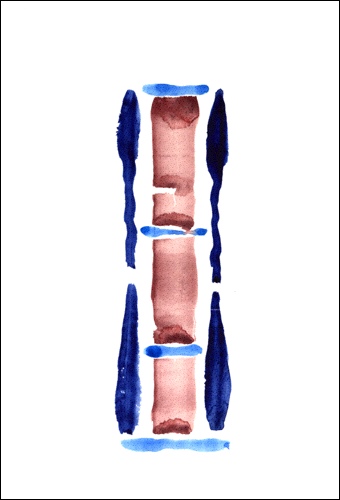
Untitled (#3087) 14 3/4 x 10 3/8 in
Bowdoin College Museum of Art 9400 College Station, Brunswick ME 04011 207-725-3275 · artmuseum@bowdoin.edu
Regarding the Forces of Nature: From Alma Thomas to Yayoi Kusama
Bowdoin College Museum of Art
October 31, 2013 - February 9, 2014
This installation features works by contemporary women artists who investigate the material qualities of their medium and probe the conditions of human perception. Grounded in a conceptual understanding of art, most of the works on view do not represent the natural environment in a recognizable way. Rather, these paintings, drawings, prints, photography, and sculpture direct the viewer’s attention with minimal gestures. In an ongoing research process, these artists foster an awareness of and understanding of natural phenomena that, for them, are at the foundation of art and life.
The show includes works by leading artists of the last 40 years, including Polly Apfelbaum, Jill Baroff, Ann Hamilton, Christine Hiebert, Yayoi Kusama, Ann Ledy, Wendy Lehman, Sylvia Mangold, Sally Mann, Edda Renouf, Dorothea Rockburne, Alyson Shotz, Pat Steir, and Alma Thomas. The exhibition brings together significant loans with selected museum acquisitions and donations from the distinguished collection of Wynn Kramarsky.
details: http://www.bowdoin.edu/art-museum/
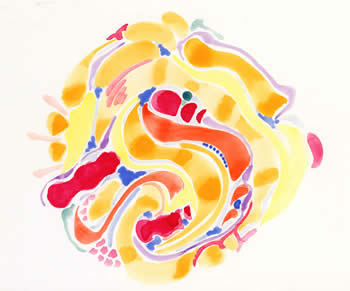
sea swirl
"Stepping Stones"
an exhibition of Painting and Sculpture by Wendy Lehman
Opening Reception:
Tuesday October 29th from 5-7pm
at The Century Association
7 West 43rd Street (between 5th and 6th ave.)
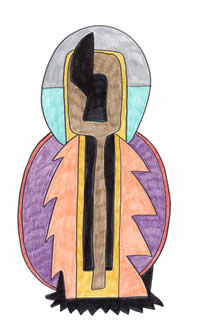
VILLAGE OF OSSINING BICENTENNIAL (1813 - 2013) SCULPTURE EXHIBIT
May 5, 2013 - October 26, 2013
"Honoring Its Past-Embracing The Future"
The cornerstone of the “Ossining in 3D” celebration will be a large-scale, 25-piece outdoor sculpture exhibit with installations in place from May through October throughout the Village’s historic buildings and downtown waterfront area. The six-month juried exhibition will provide direct and free access to art for thousands of residents and visitors.
Public Tours will be held monthly starting in June... http://www.celebrateossining.com/event_03.html
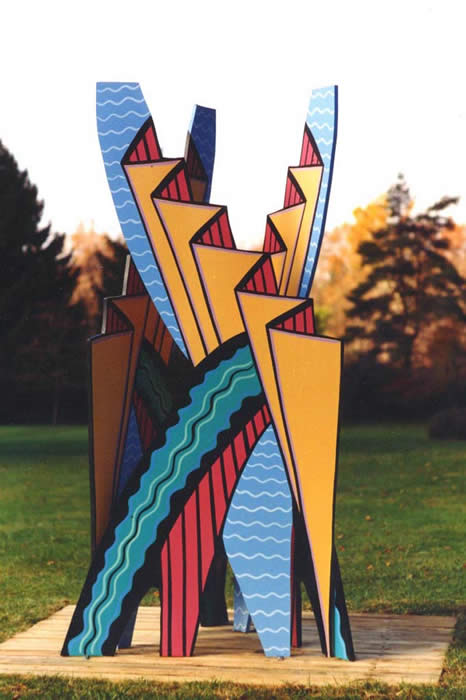
Fan Dance, painted hexcel aluminum, 120 x 76 x 48 inches
The Dorothy and Herbert Vogel Collection:
Fifty Works for Rhode Island
Friday, July 20 through Sunday, December 2, 2012
The RISD Museum celebrates the generosity and vision of contemporary art collectors Dorothy and Herbert Vogel, who gave the Museum a large art donation as part of their Fifty Works for Fifty States project.
Their gift includes paintings and sculptures by Cheryl Laemmle, Wendy Lehman, Don Hazlitt, Alan Shields, Charles Clough and Joel Shapiro. The Vogels’ gift also encompasses works on paper by Robert Barry, Lynda Benglis, Nam June Paik, and Edda Renouf.
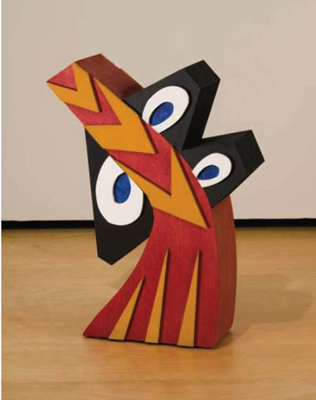 Going Dotty, acrylic on wood, 23 x16 3/4 x6 1/8", 1981
Going Dotty, acrylic on wood, 23 x16 3/4 x6 1/8", 1981
The Vogels, a postal clerk and a librarian, built one of the world’s finest contemporary art collections in their small Manhattan apartment, using Herb’s income to acquire more than 4,000 works over a span of 50 years. Called “thoroughly modest Medicis” (The Telegraph, UK), the couple sought out and encouraged relatively unknown artists who would later receive international acclaim, including Sol LeWitt, Richard Tuttle, and Christo. When their collection outgrew their one-bedroom apartment, the Vogels looked to the National Gallery of Art in Washington, DC, where about 1,100 works have been gifted. But its sheer size—far too large for any one institution—led the Vogels and the National Gallery, with support from the National Endowment for the Arts and the Institute of Museum and Library Sciences, to also give 50 works of art to one institution in every state, making this one of the largest and the most significant philanthropic projects in American art history.
The Fifty Works for Fifty States project is accompanied by an illustrated catalogue funded by the National Endowment for the Arts.
Fall 2012
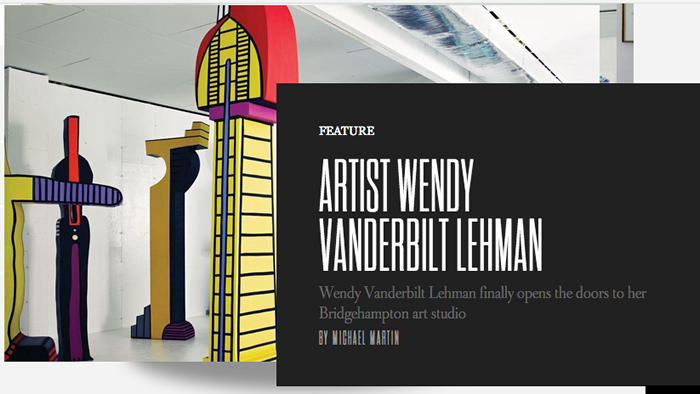
ARTICLE; ARTIST WENDY VANDERBILT LEHMAN
by Michael Martin
http://www.dujour.com/2012-09/artist-wendy-vanderbilt-lehman
The artist is ill at ease. A visitor has invaded the space that is supposed to break an artistic block, and he is perhaps contributing to it. He asks questions that are difficult. For Wendy Vanderbilt Lehman a lot is at stake. Things have to be carefully considered.
First important detail: Yes, Vanderbilt as in that family.
Her studio is behind her summer home, a wood-shingled place in Bridgehampton, N.Y., the Hamptons suburb that partly serves as an artists’ enclave (home to the studios of the painters Mary Heilemann and Vija Celmins). Some of her aluminum sculptures sit in the front and back yards, or- ganic forms in vibrant colors: red, orange, purple.
“I’m a ’60s artist,” says Lehman, settling on a comfortably worn couch in her new studio (an artist’s dream: a small structure with pure-white walls and stations for drawing, watercolors and painting). As for the inspiration for her prolific output, she says, “Where does it all come from? I couldn’t tell you. I really just do what I feel like doing.” Her work ranges from drawings to paintings to those sculptures, giant crosses and curves in wood and aluminum that rise to 8 to 12 feet.
It is all—to speak in pure art-history terms—very good. Ray Stark and Horst Koch have collected her sculptures. Twelve pieces were purchased by fabled modern-art collectors Herb and Dorothy Vogel—whom the acclaimed 2008 documentary Herb & Dorothy revealed to be prescient to the point of clairvoyance, having bought Sol LeWitt and Roy Lichtenstein pieces when those artists were just starting out. Lehman’s works sit on the campus of the University of California at Santa Barbara. They are in the National Gallery of Art in Washington, D.C., and other museums from Alaska to Hawaii.
But Lehman has no gallery and no agent at the moment. “When someone says they’ve heard of my work, I’m startled,” she laughs. “It just doesn’t happen. People see me online, and they want to show colored sculpture in Oneonta [N.Y.] or something, and off they go. I am really bad at promotion, and it’s an upbringing thing. . . . We were taught not to ask for things. Not to push yourself forward.”
Moving over to her desk, she opens a ledger, the record of her work in pencil. There are thousands of entries. She points to the first line, notated “1964.” “Number one: ‘Watercolor on illustration board,’” she reads. “Imagine having the arrogance to imagine that it would someday matter!”
Lehman has a slender frame, a brown bob, a wry humor and soft-spoken speech. Being interviewed “has put me in a panic,” she says at one point, her voice seemingly calm. “Can you hear it? I’m out of breath,” she adds, sounding perfectly placid.
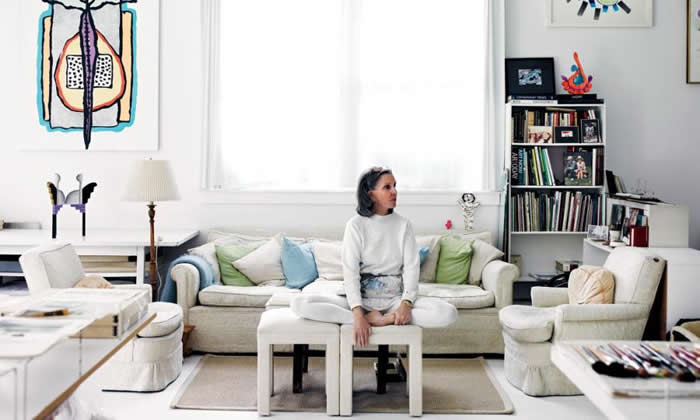
photo: Douglas Friedman
Lehman is loath to talk about herself in person but gets confessional in her work. One of the drawings on the wall of the studio is a black form with brandished teeth. “I think that one has something to do with something scary in my childhood,” she says. “Some unfinished business.”
Then she’s off to a flat file that contains hundreds of watercolors. “Come see this,” she says, opening one of the files. “I think that one is very pretty, which doesn’t bother me. I seem to like crosses for some reason. I’m not reli- gious, but there’s something structural about them—which is probably why they’re symbolic in religion.”
A visitor says that it’s been a while since he’s seen an artist’s output that’s so varied. “Oh, I don’t think it’s varied at all,” Lehman says, her voice trailing. “To me, they’re from the same person.”
So who is Wendy Vanderbilt Lehman, and where has she been? “I’ve been two distinctly different people,” she says, her eyes scanning the paintings on the wall. “And I have to get them together more.”
Wendy Vanderbilt was born in California. Her father, Alfred Gwynne Vanderbilt II, was one of the 20th century’s driving forces of thoroughbred racing. He divorced Wendy’s mother, Manuela Hudson, when their daughter was 2. Wendy’s grandfather Alfred Gwynne Vanderbilt I was also a wealthy sportsman. He died in 1915 in the sinking of the Lusitania; his brother, Reginald Claypoole, was the father of Gloria Vanderbilt and the grandfather of Anderson Cooper. Wendy was raised partly in Palm Beach, Fla., and partly in New York City. “I was that tidy little Park Avenue type girl, although I never lived on Park Avenue,” she says. “And then when I went off to boarding school, I discovered a whole new world. I was intellectually stimulated for the first time; I had teachers take me under their wing. And I found out that I was more worthy than I’d been brought up to believe.”
She has no formal art training, other than idolizing Georgia O’Keeffe, whose sister she grew up with. “She was like a granny to me.” One thing Lehman knew early: She wanted to keep her work out of the social sphere. “When I was coming out and all that stuff—the makeup and the little dresses and the Vanderbilt name—I had a lot of attention and fun. So I did that for a while,” she says. “And there were several pictures of me, with a painting or something or another. I began to realize that if I kept getting my face in the newspapers, I would be a socialite artist. So on purpose, I stopped [being photographed].
“I really didn’t want that,” she says, not at all wistfully. “And I think I overdid it.”
She attended Sarah Lawrence College, “but aside from academics I was really more interested in learning how to grow up.” When she was in her twenties, she married Orin Lehman, of the Lehman Brothers banking family. The couple had two daughters.
Her career progressed in fits and starts. She gives no impression of being ambivalent or regretful about this— “My daughter once said that children are the ultimate sculptures,” she says—just of wanting to be recognized for the right reasons. While raising the children, she went to her studio on 82nd Street near 1st Avenue in Manhattan, first for a few hours while the children were in nursery school, then a few hours more as they grew.
The Lehmans divorced in 1995; Orin died in 2008. “People have said to me that to make something of myself in that area, I should add my name back in order to get attention,” she says. “I used to say to Orin, ‘I’m going to use your name when I’m mediocre, and when I hit it big, I’m taking mine back.’ ” She has never felt comfortable with the idea of self-promotion. “When I would go to an opening at Dia or the Drawing Center, or sitting across from someone at dinner, I would never try to cultivate someone for myself. I feel that’s bad manners.”
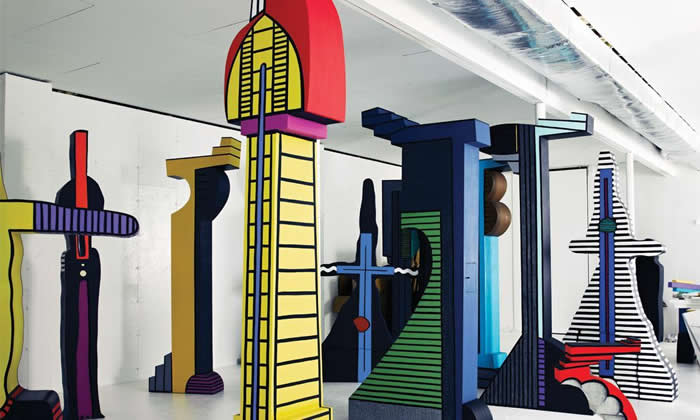
photo: Douglas Friedman
Lehman shows the visitor a sculpture of a cross, 8 feet tall and cobalt blue, carved of wood. Called “Captive Audience,” it has a door on the side that contains a tiny duplicate of the larger piece. “This is one of my favorites. I’m not a meaning-laden painter. Usually after I’ve done something, I’ve figured out what was on my mind. But this to me has to do with having your intrinsic soul, then someone plunks a Russian doll on top. You might be black, you might be white, you might be lame, you might be a man, you might be a woman, and the inner person has to deal with the outer person for the rest of their life—deal with that person’s abilities, personality and foibles. But which one is the captive audience? The one inside of having the outside, or the outside one of having the inside?”
It’s a highly conceptual question. But Lehman does not consider herself part of that movement, or any other; she has created her work without even the most casual relationship or dialogue with contemporaries. “I’ve never been someone who’s been with artists,” she says. “My children were at school. When they came home, I came home. I couldn’t go downtown and hang out and be tribal as I would have wanted to.”
Lehman started creating the sculptures in 1980—she would mail or fax small drawings to a house builder, who would cut pieces magnified many times, and she would fit them together herself. She sold her first work the next year; she made them until four years ago. That is when she briefly “came apart,” and she hasn’t made new work since. To get her creative life started again, she decided to move her studio to Bridgehampton. It has just been built; she is still moving in. And now she is trying to get back to work.
She leads the visitor down to the basement of the studio, which is a storage space that could pass for a gallery, filled with sculptures. “Here I am lucky to have a nice house, a studio, an apartment, children. The artist in me was taught things in school that saved my life when I was older. I need to learn how to be an active artist all the time. . . . I was a whole other person when I went off into that more intellectual world, where you are admired for what you did—meritocracy.”
And then, when the visitor begins to leave, she turns motherly, making the offer of a jacket to cope with the overactive air-conditioning on the train back to Manhattan. “I have plenty,” she says. “In all sizes!” Maybe she too will find one that fits.
Summer 2012
Bridge Gardens; Uncommon Ground III
a sculpture exhibition featuring the work of seven internationally recognized artists
June 20 through September 10, 2012.
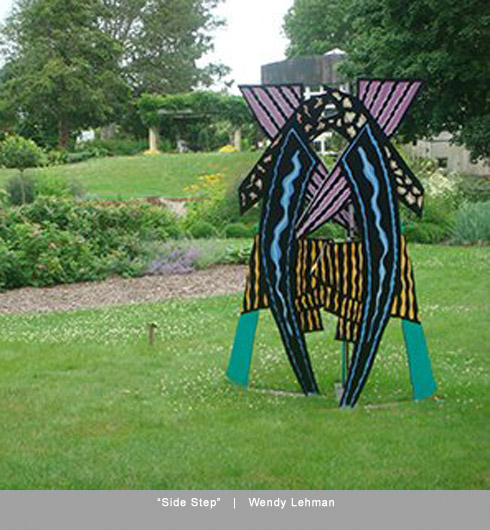
Opening Reception: Saturday, July 21st 6:00 - 8:30pm
Uncommon Ground III, now in its third year at Bridge Gardens, the exhibition further explored our relationship with the natural world and the one which we create.
The dynamic of the garden itself, with its undulating play between the purely natural and "cultivated," provides the substrate or "ground" from which the sculptures are seemingly born.
Many of the pieces were created expressly for the Bridge Garden landscape; forms spring forth from the rich garden soil where they were seeded and nourished, shapes swing from trees echoing limbs and branches, or flower from nearby hedges in boldly colored shapes and textures. Structures beget paths and vestibules, walkways or caverns and direct us through or around themselves, each creating a unique spatial reality, one which confronts and interacts with the viewer on a variety of levels.
The exhibition explores these ideas though the hands of seven contemporary artists working in a variety of materials and techniques. All of the artists represented are supported by an established record of fellowships, awards and have extensive exhibition histories with galleries, museums and public works venues throughout the United States and Europe.
The artists are: Hans Van de Bovenkamp, Steve Tobin, Gino Miles, Wendy Lehman, and retruning artists Joel Perlman, Michael Enn Sirvet, Kevin Barrett.
The show is curated by Cheryl Sokolow of C Fine Art, New York. http://www.c-fineart.com
JANUARY 2012
WENDY LEHMAN STUDIO OPENS IN WATERMILL, NY
TO MAKE AN APPOINTMENT TO VISIT EMAIL: WVLEHMAN@EARTHLINK.NET

SUMMIT PATCH
ARTS
Lehman Sculptures Newest Additions to Public Art Scene
Three new sculptures have been installed on Summit grounds thanks to the Mayor's Partnership for Public Art.
By Michelle Colandrea May 24, 2010
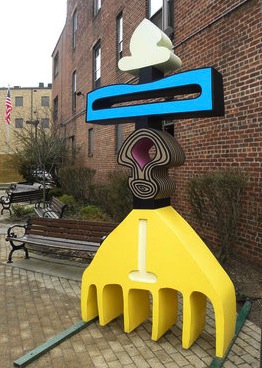
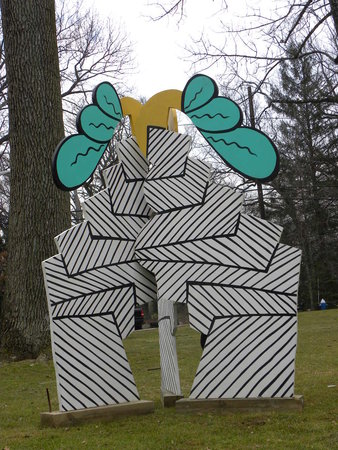
The Mayor's Partnership for Public Art has done it again, adding three new sculptures to the Summit landscape. Residents and out-of-town visitors will notice artist Wendy Lehman's Boxwood at the intersection of Elm and Mountain Avenues andTrue Blue in the Promenade Park on Springfield Avenue.
A third sculpture stands on the Summit High School grounds and is titled Nodding Acquaintance.
"I hope (Summit residents) will like the experience of seeing new art around them and hope they will become fond of some of the work, finding themselves looking at their surroundings in a new way," said Lehman of the city's newest acquisitions.
Boxwood (84 x 67 in.) and Nodding Acquaintance(101 x 90 x 90 in.) are both fashioned from Hexcel aluminum and painted in a variety of colors and patterns. True Blue (110 x 56 x 17 in.) is made from aluminum, painted with acrylic paint.
"My aim is to communicate with the viewer primarily on a subconscious level and secondarily on an intellectual one," explains Lehman in the personal statement on her Web site. "Generally I work in a series and only much later when the work is finished do I analyze the choices I made and try to discover why the work took the form it did and what the psychological or intellectual content might be."
Lehman, who is originally from California, now resides in New York City where she also works. Her paintings and sculptures have been exhibited in renowned galleries and grounds throughout America including The National Gallery of Art in Washington D.C., the Yellowstone Art Museum in Montana, New Jersey's Grounds for Sculpture, and the Las Vegas Art Museum in Nevada, among numerous others.
Her artwork is also found in numerous private collections as well as several public businesses and establishments throughout the country.
The artist credits Michael Tcheyan, Co-Chair of Public Art/Summit, for selecting the three pieces that are currently on display in town.
Some of the forms and figures in her sculptures may seem recognizable, but Lehman said that her work "tends to be spontaneous."
However, she explained that Boxwood is an exception to this trend and was created in response to the past experiences of her younger daughter, Sage.
"She was having a difficult time one year at school and was not receiving their help or encouragement—quite the contrary," said the artist. "Despite that, she blossomed… rather like the proverbial green sprout which manages to pop up between the cracks in the sidewalk. Immediately when I finished the piece I knew 'where it came from.'"
Lehman has displayed some of her sculpture outdoors in Summit back in 2005 when the Mayor's Partnership for Public Art (also known as Public Art/Summit) was still a young organization.
Public Art/Summit has now been established for 15 years and has served to bring more than 30 public art projects to all corners of the city.
September 16, 2009 through February 26, 2010
INTERPLAY: art. audience. architecture
An Exhibition of Sculpture.
Perelman Center for Advanced Medicine
First Floor, Atrium Level.
3400 Civic Center Boulevard, Philadelphia, PA
Artists: Wendy Lehman, Lanny Bergner, Nancy Graves, Donald Lipski,
Linda Brenner, Jun Kaneko, Warren Muller, Fritz Dietel and Robert Roesch
Curator: Marsha Moss
OPENING SEPTEMBER 16TH 6PM.
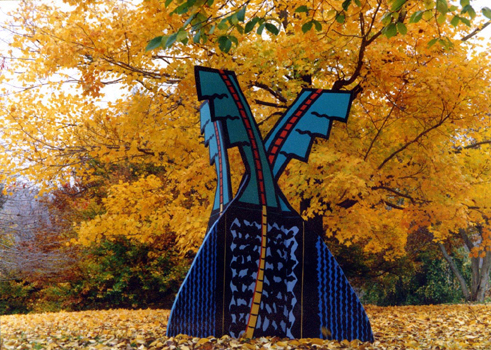
NODDING ACQUAINTANCE. painted hexcel aluminum, 101x90x90"
May 29-September 8, 2009
CURRENT within.without
Sculpture Exhibition 2009
on the grounds of Boscobel, Route 9D, Garrison, NY
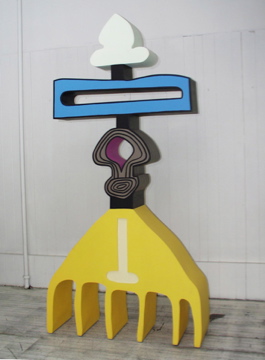
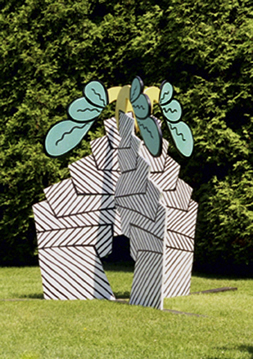
True Blue, 110x56x17, imron on aluminum Boxwood, 84x67, painted hexcel aluminum
Wendy Lehman with artists Joy Brown, Bo Gehring,
Lucy Hodgson, Blake Hoke, Bertil Petersson, Matt Rink and Ed Smith.
Garrison Art Center 845-424-3960 www.garrisonartcenter.org for directions.
return to CURRENT news and shows